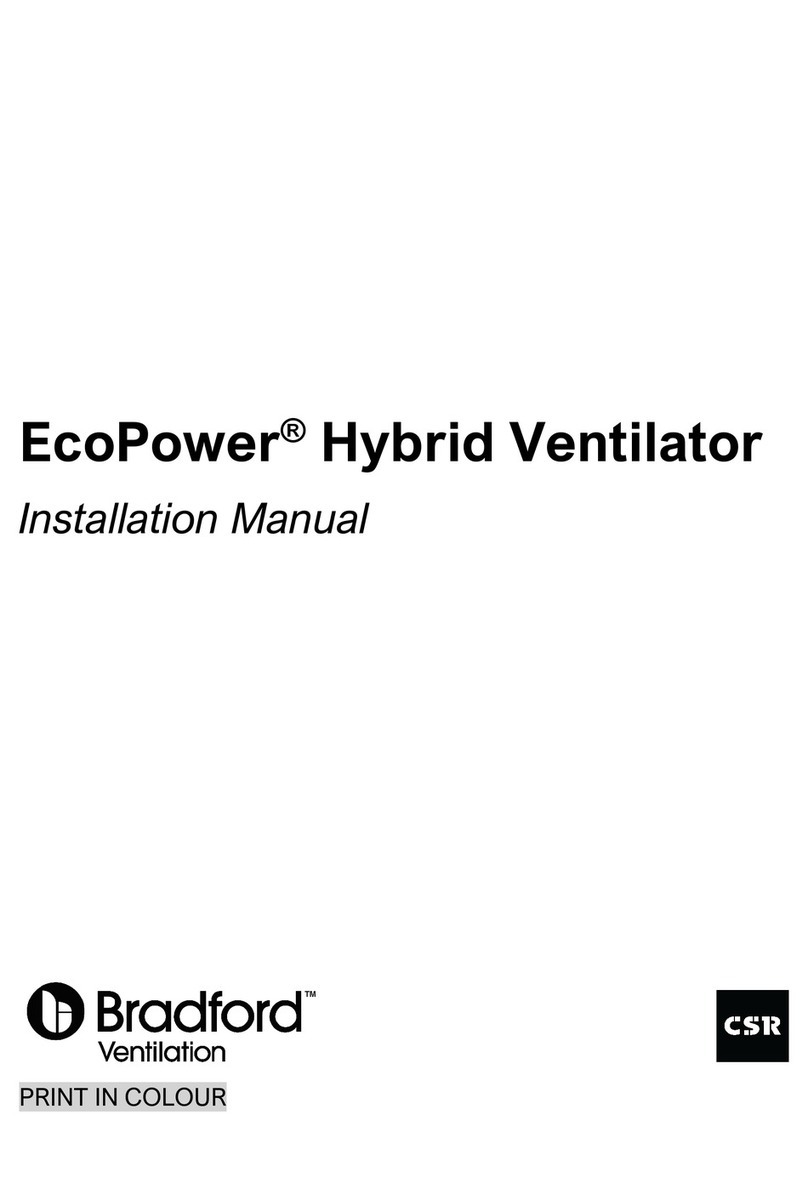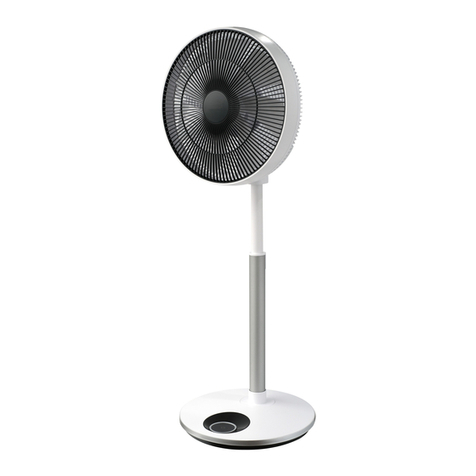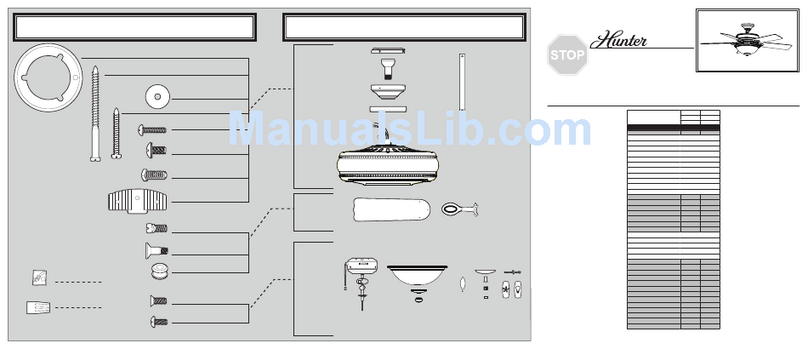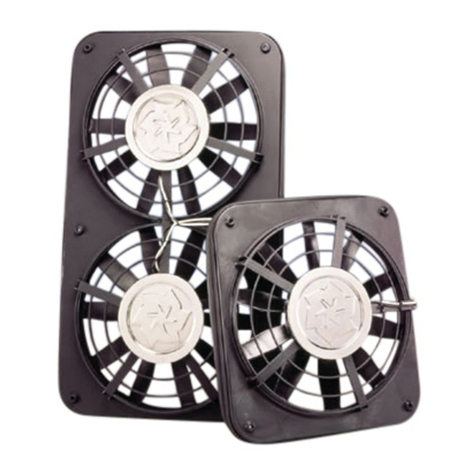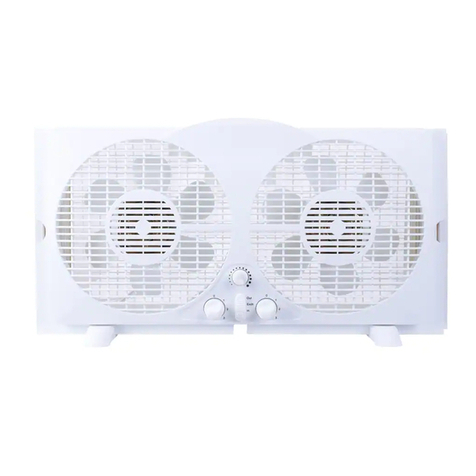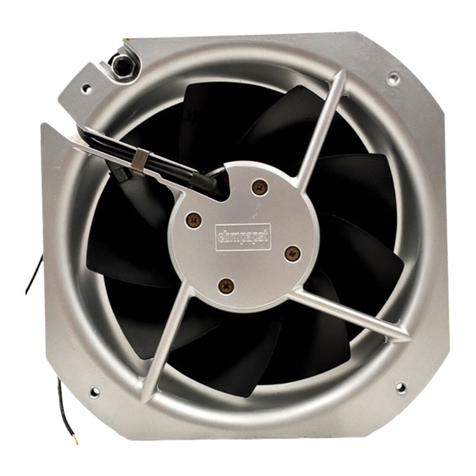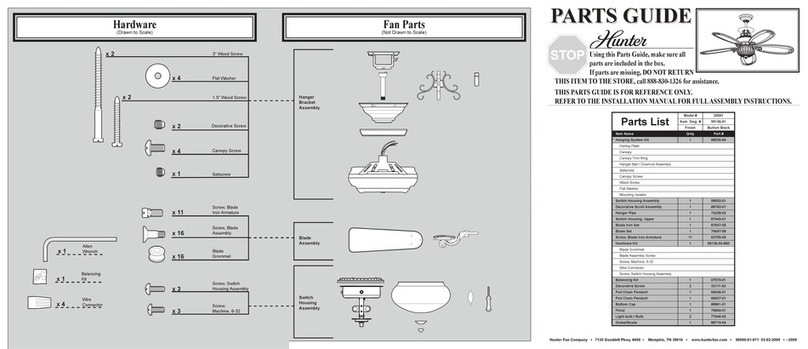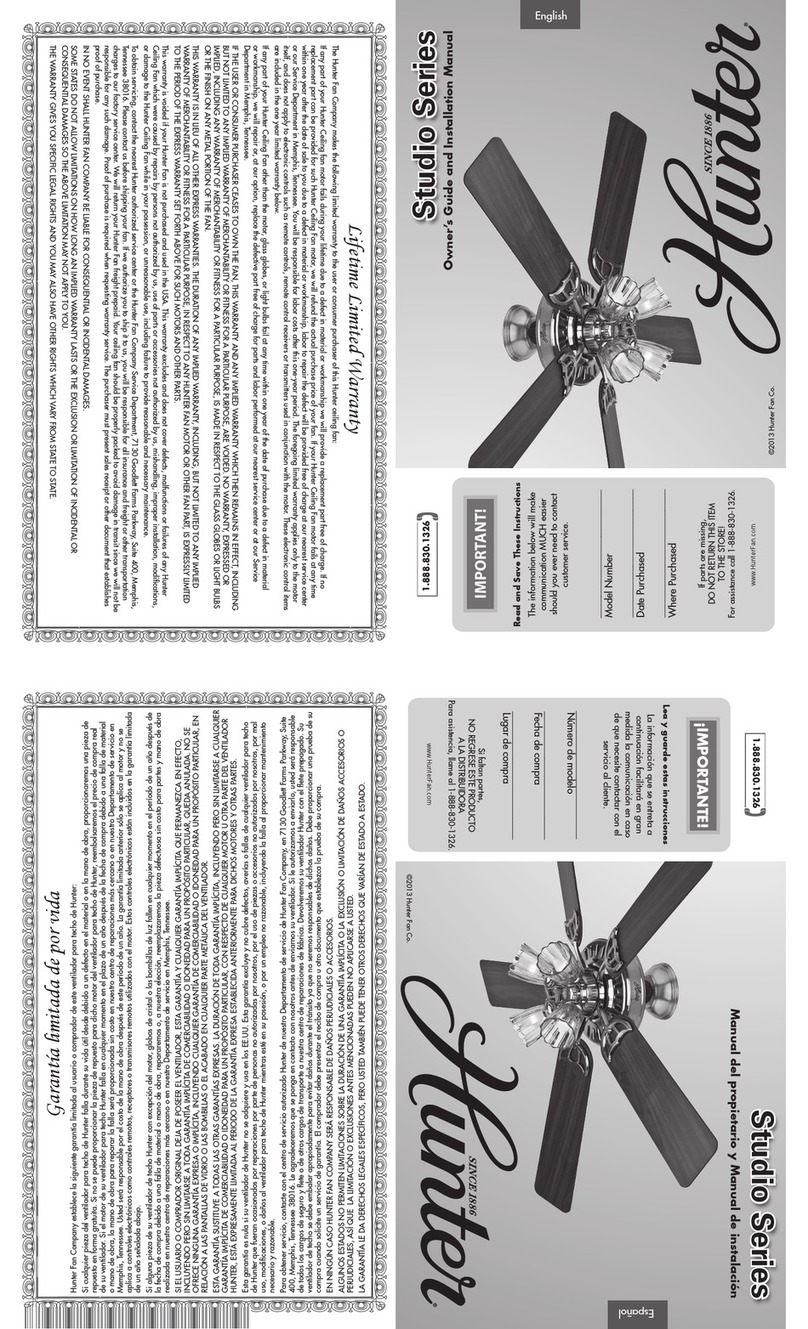Bradford WindMaster BAL User manual

Installation Manual
WindMaster BAL
V6.0 11/23

2
Item Checklist & Additional Tools Required For Installation
1Windmaster Top 1
2Varipitch 1
3Flashing with Integrated Mesh 1
4Fixing Strap 1
5Screw Pack 1
6Instruction Document 1
7Warranty Document 1
Soft Rubber Mallet
Caulking Gun
Weatherproong Sealant
Hand tile cutter (Tile roof only)
Screw/Nail for fastening Fixing Strap (Tile roof only)
Knife
UltraTape or Hightack Tape (Sarked roof only)
Tin Snips
Nibbler or Similar Cutting Tool (Metal roof only)
10G Tek Screws or Sealed Rivets (Metal roof only)
Cordless Driver with #2 Phillips Bit
Combination Pliers
Additional Parts & Tools Required (Not Supplied)
Included Parts: Qty:

3
4
1
2
3
5
x6 x1
(for varipitch clip)

4
Warnings and Important Notices
WARNING:
Do not proceed with the installation until you have read the entire
instruction manual, including these warnings.
The product warranty does not cover defects to the ventilators caused by
faulty installation or modication without the authorisation of Bradford Ven-
tilation.
INSTALL AT YOUR OWN RISK
The installation of this product may be dangerous and includes working at
heights - appropriate safety precautions should be taken prior to commenc-
ing. Please be aware of the following before installing this product.
• Follow all State or Territory, Regulator or OH&S guidelines for working
at height (e.g. roof work), electrical, working in conned space.
• Installation may require working at height and should only be
undertaken with the correct safety equipment.
• Do not attempt to install this product if it is not safe to do so.
• Isolate power before installation.
• It is recommended that appropriate cut resistant gloves and safety
glasses be worn whilst handling these products and during
installation.
• Caution: The turbine head of this product can rotate without warning
(even during installation) – always keep body parts away from moving
components.
• WARNING: Before commencing the installation always check roong
and other building material for the presence of asbestos prior to cutting.
If asbestos is present or the type of material is unable to be determined,
do not proceed with the installation and seek expert advice.
• WARNING: Refrain from using a grinder to cut the roof tiles to avoid
exposure to resipirable crystalline silica dust. Instead, opt for a hand
tile cutter. Refer to the CSR silica fact sheet for details : https://www.
monier.com.au/roong-information/-/media/monier/documents/2023-
updates/monier-silica-fact-sheet_0523.pdf

5
Warnings and Important Notices
PRODUCT COMPLIANCE:
Compliance of this product to BAL requirements relies upon correct instal-
lation. It is recommended that installation is undertaken by a competent
and licensed tradesperson to ensure that the product installation is in
accordance with this Guide. In particular, care should be taken when
forming the ashing to ensure that there are no gaps between the roong
material and the ashing greater than 2mm. Seal any gap less than 2mm
with weatherproong sealant for weatherproong purposes.
IMPORTANT
Do Not Modify This Product: Compliance with BAL requirements is only
achieved by the unmodied product as supplied.
MAINTENANCE
This product requires regular maintenance to maintain its performance
- check and clean the emberguard (mesh) regularly to remove built-up
residue.
PRODUCT SUITABILITY:
Always check product suitability and limitations of use prior to selection –
refer to the Product Technical Statement (PTS) available online.

6
Installation - Tiled Roof
STEP 1
Select a suitable position
along the roof that has no
obstructions below the tiles
(such as a rafter or cross
brace).
IMPORTANT: It is
recommended that the
ventilator be installed
along the 3rd or 4th row of
tiles from the ridge. Lower
positions will return lower
vent performance and
increase the risk of leakage
in heavy rain.
Installation higher than the third row of tiles down from the
ridge may damage the ridge tile pointing and is NOT recom-
mended.
STEP 2
Position the ashing in the de-
sired location so that the tiles
that need to be cut or removed
can be determined.
Ensure the bottom edge of the
ashing extends far enough be-
yond the lower tile edge to allow
it to be folded downward toward
the roof at a later stage.
Mark-out the position to either
remove and/or cut the required
tiles.
Ensure the ashing is positioned with the slots for the xing
strap located at 12 and 6 o’clock mark. This is crucial for x-
ing strap assembly (see Step 10).

7
Installation - Tiled Roof
STEP 3
Cut the tiles marked
earlier using a hand tile
cutter being careful not
to crack the tile.
Refrain from using a
grinder to cut the roof
tiles to avoid exposure
to resipirable crystalline
silica dust. Instead, opt
for a hand tile cutter.
STEP 4
If the roof is sarked, cut
sarking in a cross and fold
back onto itself to give
an opening to match the
vent’s throat diameter.
Tape the corners to the
top surface of surround-
ing sarking with a suitable
tape to prevent them foul-
ing the ventilator.
Depending on roof construction, a tile batten may be obstructing
the throat opening of the vent. This batten can be left in place with
the ventilator sitting above it.
Folding the cut sarking aps back on themselves results in a
gutter arrangement that helps to prevent any water running down
the sarking from entering through the opening.

8
Installation - Tiled Roof
STEP 5
Lift the higher row of tiles
and use a piece of timber
or similar to wedge to the
tiles in the up position.
Return the ashing to the
roof and place it under
the upper row of tiles in
the previously marked
position (step 2).
STEP 6
Using a soft hammer, form
the ashing to conform with
the lower tile prole.
Position the varipitch
temporarily onto ashing and
make any nal adjustments to
the ashing position. Turn the
bottom edge of the ashing
over the lower tiles. Form the
bottom edge of the ashing
so that the higher tiles can be
replaced with minimal gaps.
Remove the varipitch for next
steps.
Take care to avoid unnecessary movement of the top row of
tiles. Ensure the ashing is positioned with the slot for the
xing strap located at 6 o’clock mark
SLOT
Care should be taken when forming the ashing so that the gaps
between the roong material and the ashing are less than 2mm.

9
Installation - Tiled Roof
STEP 7
Remove the formed
ashing.
From above the roof, take
the xing strap and securely
x it to the vertical face of
lower tile batten.
Screw (not supplied) the
xing strap to the batten,
this will secure the lower
part of the ashing in future
steps.
STEP 8
Gently bend the upper
part of the strap so that
it is facing down the roof
and is approximately the
height of the ashing above
the surrounding roof tiles.

10
Installation - Tiled Roof
STEP 10
Remove the screw from the
lower part of the ashing -
this screw should located
adjacent to a cut-out slot.
STEP 9
Install the cut portion of
the tile so that it is inline
with the lower edges of
the surrounding tiles.
Using a weatherproong
sealant, apply a 15-
20mm wide bead of
sealant around the
perimeter of the ashing
area.
Apply SealantApply Sealant
Ensure sufcient weatherproong sealant applied in tile troughs.
This helps prevent any water entering from adjacent tiles.
SLOT

11
Installation - Tiled Roof
STEP 11
Position the ashing to the
marked position and slide the
xing strap between the mesh
and ashing.
Once the ashing is in its
correct position, pull the strap
tight and then screw the
strap to the ashing using the
screw previously removed.
Cut the excess length of strap
ush with the edge of the
mesh ring before proceeding.

12
Installation - Tiled Roof
Ensure the top of the varipitch is horizontal relative to both the
lateral axis across the roof and the longitudinal axis in-line with
the roof pitch.
Notch
STEP 12
Check that the bottom edge
of the ashing is neatly bent
over the lower tiles and
there are no gaps greater
than 2mm. If required, form
the ashing using a rubber
mallet so it matches the
prole of roong tiles as
close as possible.
STEP 13
Position the varipitch over the
ashing upstand.
Using a spirit level for
guidance, rotate the two
varipitch halves until the top
of the varipitch is horizontal
in all directions. Varipitch
adjustments are best
made off the ashing and
then returned to check the
position.
Ensure the varipitch is the
correct way up by keeping the
notched edge to the top.
Care should be taken when forming the ashing so that the gaps
between the roong material and the ashing are less than 2mm.
Seal the gaps less than 2mm with weatherproong sealant.

13
STEP 14
Check the varipitch level
again and ensure it is still
level across all directions.
Screw the varipitch to the
ashing with the three
screws provided at the
pre-drilled holes on the
varipitch.
Lock the varipitch by
screwing the xing clip
into the lower half with
the one small single screw
provided in the screw
pack.
Fix with supplied screws
Lock Varipitch
Lock Varipitch
Fix with supplied screws
Apply weatherproong sealant internally to the varipitch seam and the
four screws. Do not seal the varipitch to the ashing.
Fix with supplied screws
Fix with supplied screws
Installation - Tiled Roof
Ensure the mounting points are properly secured on the top and
bottom ring of the varipitch.
STEP 15
Position the ventilator top
onto the top of the varipitch.
The three arms on the
bottom of the turbine must
align with the three notches
on the varipitch with the
arms positioned on the
outside face of the varipitch.
Fix the ventilator top to the
varipitch with the three
screws provided through the
pre-drilled holes.

14
TURN UP TURN UP
TURN UP TURN UP
Installation - Metal Roof
STEP 1
Select a suitable position for the
ventilator along the ridge line of
the roof.
Remove the nearby screws
from the ridge cap to allow the
ashing to be slipped under it.
Slip the top edge of the ashing
under the ridge cap to mark the
size and position of the round
(300mm diameter) cutout by
lifting and marking the roof
repeatedly - alternatively use a
300m diameter cardboar tem-
plate to mark the hole.
The vent must be installed
to the ridge cap. Any other
installation requires a
competent and licensed
tradesperson.
STEP 2
Remove the ashing and cut
a square or round opening
around the centre of the
position marks. (Minimum
300mm diameter
Turn up the corrugations or
pans on both the low and
high sides. This will help to
prevent water ingress.
Ensure that the ashing covers the roof corrugations or ribs
equally and that it is located between roof rafters.

15
Installation - Metal Roof
STEP 3
Return the ashing to
the roof, positioning
it over the cutout.
Ensure that the top of
the ashing is slipped
under the ridge capping.
Remove ridge cap
screws as required.
For lower pitched roofs,
turn up the top edge
of the ashing before
slipping under ridge
capping. This will help
prevent water ingress.
STEP 4
Using a pair of tin
snips, cut the bottom
edge of the ashing to
match the roof prole
(waveform shape). This
will help ensure the
lower prole of the roof
covered by the ashing.

16
Installation - Metal Roof
STEP 5
Using a soft rubber
hammer, carefully
work around the sides
and lower edge of the
ashing to form it into
the corrugations of the
metal sheeting prole.
STEP 4 a
Alternatively the bottom
edge of the ashing can
be cut in triangular wave
shape.
Care should be taken when forming the ashing so that the gaps
between the roong material and the ashing are less than 2mm.

17
Installation - Metal Roof
STEP 7
Return the ashing to
the roof. Slide it under
the ridge capping and
press it down onto the
weatherproong sealant.
STEP 6
Remove the formed
ashing off the roof
sheeting.
Apply a 15-20mm wide
bead of weatherproong
roong sealant to the
roof approximately 20mm
in from the edge of the
ashing.
Apply SealantApply Sealant
Care should be taken when forming the ashing so that the gaps
between the roong material and the ashing are less than 2mm.
Seal the gaps less than 2mm with weatherproong sealant.

18
Notches go to the top
Installation - Metal Roof
STEP 9
Using a spirit level for guidance,
rotate the two varipitch halves
until the top of the varipitch is
horizontal.
Varipitch adjustments are best
made off the ashing and then
returned to check the position.
Ensure the varipitch is the
correct way up by keeping the
notched edge to the top.
STEP 8
Secure the ashing to the metal
sheeting with 10G Tek screws or
sealed rivets along the 3 exposed
edges of the ashing. Approxi-
mately 12 fasteners are required
(not supplied). Use weatherproof-
ing sealant to seal the screws.
Ensure the ashing top edge is
xed via existing ridge capping
screws. This prevents gaps
forming due to thermal expansion
and prevents ingress of rain or
embers during a bushre event.
Ensure the gaps between the
roong material and the ashing
are less than 2mm. Seal the
gaps less than 2mm with
weatherproong sealant.
Take care to ensure the varipitch is level in all directions.

19
Installation - Metal Roof
STEP 10
Check the varipitch level
again and ensure it is still
level across all directions.
Screw the varipitch to the
ashing with the three
screws provided at the
pre-drilled holes on the
varipitch.
Lock the varipitch by
screwing the xing clip
into the lower half with
the one small screw
provided in the screw
pack.
Fix with supplied screws
Lock Varipitch
Apply sealant internally to the varipitch seam, varipitch locking
screw and the three screws securing the varipitch to the ashing.
Do not seal the varipitch to the ashing.

20
STEP 11
Position the ventilator
top onto the top of the
varipitch.
The three arms on the
bottom of the turbine
must align with the
three notches on the
varipitch.
Align
Installation - Metal Roof
STEP 12
Fix the ventilator top to
the varipitch with the
three screws provided
through the pre-drilled
holes.
Fix with supplied screws
Notch
Table of contents
Other Bradford Fan manuals
Popular Fan manuals by other brands

Ebmpapst
Ebmpapst W2G115-AD15-13 operating instructions
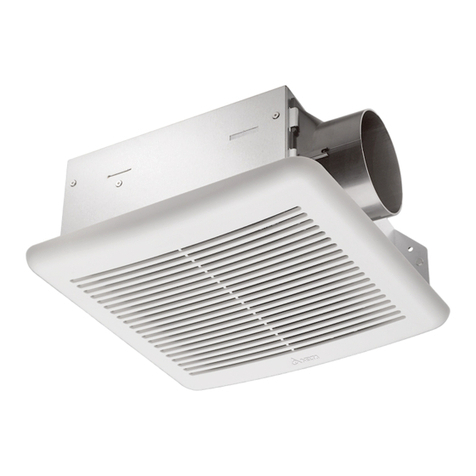
Delta
Delta Breez VFB70F Installation and operating instructions

Gulf Coast Fans
Gulf Coast Fans 4YU26 owner's manual

Ebmpapst
Ebmpapst D4E225-CC07-37 operating instructions
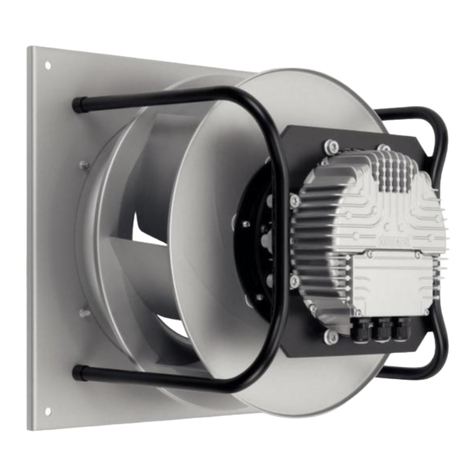
Ebmpapst
Ebmpapst K3G400-RJ75-01 operating instructions
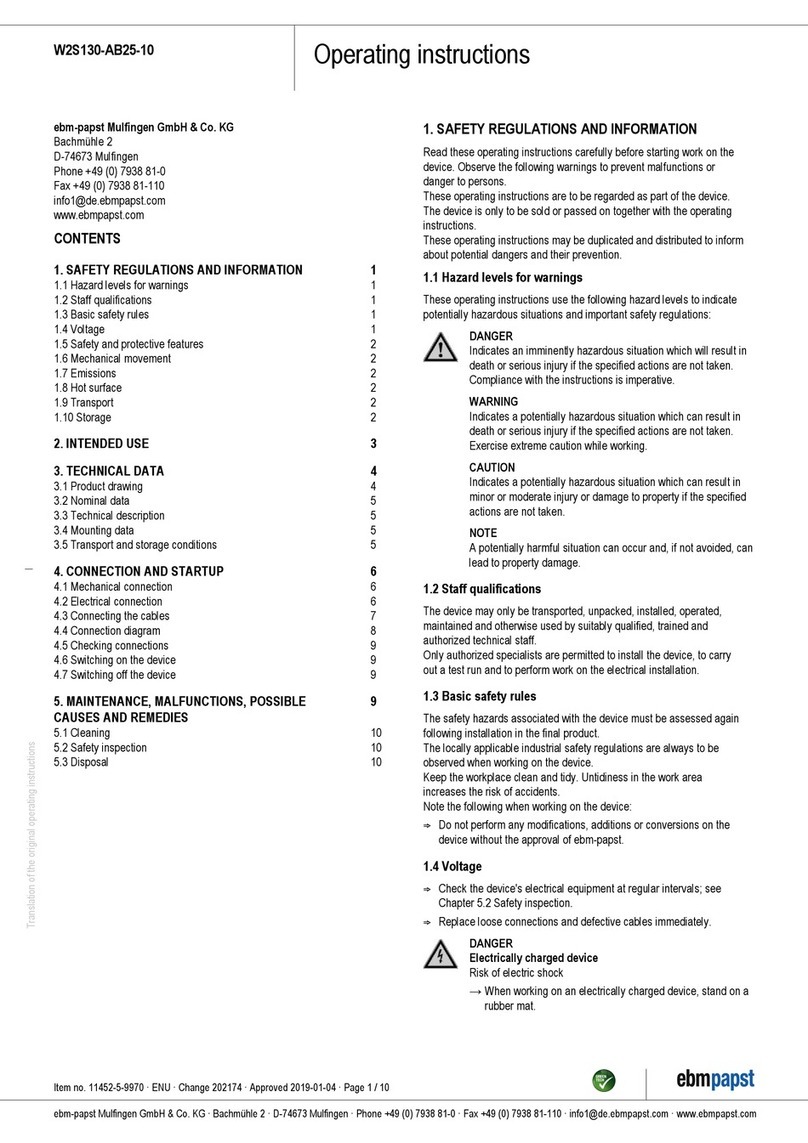
Ebmpapst
Ebmpapst W2S130-AB25-10 operating instructions
